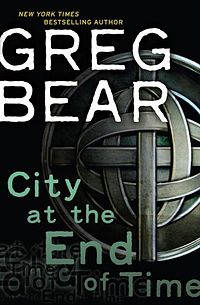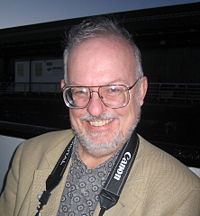- City at the End of Time
-
City at the End of Time 
US first edition cover (Del Rey)Author(s) Greg Bear Country United States Language English Genre(s) Science fiction novel Publisher Del Rey (US)
Gollancz (UK)Publication date August 2008 Media type Print (hardcover) Pages 496 ISBN 0-345-44839-1 (US)
0-575-08188-0 (UK)City at the End of Time is a 2008 science fiction novel by American Hugo and Nebula Award-winning writer Greg Bear. It was published in August 2008 by Del Rey in the United States, and Gollancz in the United Kingdom. The story follows three drifters in present-day Seattle who are tormented by strange dreams of the Kalpa, a city one hundred trillion years in the future. The Kalpa is attempting to ward off the Typhon, an inexplicable entity that has consumed the rest of the ancient universe and broken down the laws of physics.
The novel belongs to the Dying Earth subgenre and is a homage to William Hope Hodgson's 1912 novel, The Night Land, with which it shares a number of plot elements.[1][2] City at the End of Time was nominated for both the Locus and the John W. Campbell Memorial Awards in 2009.[3]
Contents
Plot summary
City at the End of Time is about the Kalpa, the last city on Earth, one hundred trillion years in the future. The novel's back-story describes how the aging universe continued expanding and its spacetime fabric weakened. With the galaxies burnt out, humanity dispersed across the cosmos, where they encountered the Typhon, an inexplicable entity that was destroying the decaying universe. It consumed matter and replaced space-time with emptiness and inconsistencies beyond the laws of physics. The resulting Chaos spread rapidly, driving some humans back to ancient Earth with its rekindled sun. In an attempt to fend off the approaching Typhon, leaders of the dying Earth sent for Polybiblios, a human living with the Shen, an ancient alien race. Polybiblios returned to Earth with his adopted daughter, Ishanaxade, a being he had constructed from "fate-logs"[4] of intelligent species collected by the Shen. After the Shen system fell, and the Chaos surrounded Earth, its leaders instructed everybody to convert themselves from primordial (real) matter to noötic (virtual) mass. As each city fell, its inhabitants retreated to the last remaining cities, the Kalpa and Nataraja. Using knowledge he had gleaned from the Shen, Polybiblios build reality generators to protect the Kalpa. Nataraja, which had rebelled the instruction to convert to noötic matter, was left to fend for itself.
The novel alternates between the Kalpa and present-day Seattle, where three drifters, Ginny, Jack and Daniel are in possession of sum-runners, small stone-like talismans that give them "fate-shifting" abilities, whereby they can jump between fate-lines (world lines in a multiverse). Ginny and Jack also have disturbing dreams of the Kalpa, and are inexplicably connected to Jebrassy and Taidba, two "breeds" living in the future city. Fate-shifters and their sum-runners are hunted by "collectors" working for the Chalk Princess, an entity controlled by the Typhon from the future. These hunters place adverts in local newspapers inviting "dreamers" to contact them for "help".
"Do you dream of a City at the end of Time?"
—Seattle newspaper ad.[5]In the future the Typhon is destroying history and world-lines are being broken, merging the past and the present. With the Chaos closing in on the Kalpa, the inhabitants (all noötic) are unable to venture outside the city walls. Under Ishanaxade's instructions they create "breeds", copies of ancient humans, using primordial matter. They send them in groups into the Chaos to find out if Nataraja still stands, but none return. Ishanaxade herself ventures out, but is not heard from again. As the Typhon starts breaching the Kalpa, the last batch of breeds, including Jebrassy and Taidba, leave the city in search of help. Armed with portable reality generators, they slowly progress through the "unreal" landscape in search of the rebel city.
Meanwhile the Chaos has reached all the way back to the present-day, and an event called the Terminus hits Seattle: the past, present and future collides and world-lines are severed. Ginny, Jack and Daniel, having evaded the hunters, trek across a degenerating Seattle. Protected by their sum-runners, they are drawn to the Nataraja, where Ishanaxade is waiting. While still in the Kalpa, Ishanaxade had instructed Polybiblios to create the sum-runners containing "fragmented Babels",[6] and in the Chaos she had sent them back to the "beginning of time".[6] The sum-runners were programmed to lead the bearers to Ishanaxade when the expected Terminus occurred. The breeds, programmed to see Ishanaxade as their "mother", are also drawn to Nataraja, and Jebrassy and Taidba find their counterparts Jack and Ginny in the ruined city. The Kalpa falls to the Chaos, but in Nataraja, the sum-runners and their Babel fragments are united and a new history is created causing the Typhon, now a failed god, to implode.
Background
Greg Bear is a Hugo and Nebula Award-winner science fiction writer from Seattle.[7] He called City at the End of Time his "longest and most ambitious science fiction novel" he has written for a while.[8] He said it is a "significant departure" from any of his previous works, and that it has a future history unlike anything he had tackled before.[7]
In an interview with Locus magazine Bear said that in this novel he honors those writers who changed the face of science fiction and fantasy, including William Hope Hodgson, Arthur C. Clarke, J. R. R. Tolkien and C. S. Lewis.[9] In particular Bear pays homage to Hodgson's 1912 novel, The Night Land, with which City at the End of Time shares a number of plot elements. Both books include characters who dream of cities ("the Last Redoubt" in Night Land) in the far future surrounded by encroaching chaos. The Kalpa also draws on Clarke's future city, Diaspar in his 1956 novel, The City and the Stars.[1][2] Influences of other past works on City at the End of Time include H. P. Lovecraft's novella The Shadow Out of Time (1936) and Olaf Stapledon's Last and First Men (1930).[10]
Reception
Publishers Weekly described City at the End of Time saying "this complex, difficult and beautifully written tale will appeal to sophisticated readers who prefer thorny conundrums to fast-paced action."[1] Sara Rutter reviewing for the Library Journal said the novel "plunging readers into a visceral experience of cosmological theory and the big creation stories of mythology, this challenging and imaginative work will receive critical attention."[11] A review in New Scientist described the first half of the book as "a gripping, original tale" with the portrayal of the fate-shifters's talents as "nothing short of brilliant", but complained that in the second half Bear over-complicates the story with "too many ideas, images, mythologies and distractions".[12] The reviewer said that a promising story "whips itself up into a virtually incomprehensible final act".[12] Science fiction critic John Clute described the book as "cosmological [science fiction] without a net", and complained that Bear rushes through the story too quickly and does not dwell long enough on venues like the Kalpa to make it memorable.[2] He said that the flight to future of Ginny, Jack and Daniel "gets a touch Frodo-in-Mordor at places".[2]
In a review at Strange Horizons, an online speculative fiction magazine, Tony Keen was critical of Bear's novel, saying that the present and future passages "do not mesh terribly well", and that it is "too long" with "too many ideas".[10] He complained that the book was difficult to follow and that Bear keeps "moving the goalposts as it suits his narrative".[10] Keen said that for a science fiction novel, he was surprised at its "lack of consistency", and called it more a work of fantasy than science fiction. He said the "revelations" at the end still did not help explain what had happened, but that "by this point, it was for me hard to care".[10]
Science fiction critic Paul Kincaid had mixed feelings about the novel. In a review at a webzine, the SF Site he said that while the novel is rooted in hard science fiction, it has a strong elements of fantasy in its plot and style. He criticized the characterisation saying that he could not always separate the main characters. Kincaid questioned the need for the supernatural entity, the Typhon, which is never developed. He described the "end of time" sequence as "the most powerful science fictional moment in this entire book", saying that he found it "far more scary, far more gripping, than any supernatural intervention".[13] Kincaid said that while he found the book "ambitious" and "intellectually satisfying", "somehow the whole feels less than the sum of its parts".[13]
In another review at the SF Site, Greg L. Johnson wrote that while City at the End of Time provides plenty of "wonder, awe, and a sense of humanity in the face of an implacable universe", he feels that Bear does not quite succeed with this ambitious story of the fate of reality and the universe at large. Johnson described it as "an immensely complicated story" that unfolds by means of "hints and allusions".[14] He said that even the book's ending only hints at what the gathered role players had achieved. Johnson wrote that while Bear's depictions of events on a grand scale, like the decay of Seattle, are good, his portrayal of the key players against this backdrop is not as strong.[14]
References
- ^ a b c "City at the End of Time". Publishers Weekly 255 (25): 41. June 23, 2008. ISSN 00000019.
- ^ a b c d Clute, John. "Cosmos Coupons". Science Fiction Weekly. Archived from the original on June 16, 2009. http://web.archive.org/web/20090616153549/http://www.scifi.com/sfw/books/column/sfw19088.html. Retrieved August 25, 2011.
- ^ "2009 Award Winners & Nominees". Worlds Without End. http://www.worldswithoutend.com/books_year_index.asp?year=2009. Retrieved August 17, 2011.
- ^ Bear 2008, p. 407.
- ^ Bear 2008, p. 61.
- ^ a b Bear 2008, p. 491.
- ^ a b "Interview: Greg Bear". SF Signal. http://www.sfsignal.com/archives/2007/04/interview-greg-bear/. Retrieved August 17, 2011.
- ^ Lohr, Michael (February 25, 2008). "City at the End of Time by Greg Bear". Strange Horizons. http://www.strangehorizons.com/2008/20080225/lohr-a.shtml. Retrieved August 17, 2011.
- ^ "Greg Bear: The Universal Library". Locus. August 25, 2008. http://www.locusmag.com/2008/Issue11_Bear.html. Retrieved August 17, 2011.
- ^ a b c d Keen, Tony (February 4, 2009). "City at the End of Time". Strange Horizons. http://www.strangehorizons.com/reviews/2009/02/city_at_the_end.shtml. Retrieved August 17, 2011.
- ^ Rutter, Sara (July 1, 2008). Library Journal 133 (12): 72. ISSN 03630277.
- ^ a b O'Neill, Sean (August 12, 2008). "City at the End of Time". New Scientist. http://www.newscientist.com/article/mg20026826.600-icity-at-the-end-of-timei-by-greg-bear.html. Retrieved August 24, 2011.
- ^ a b Kincaid, Paul (2008). "City at the End of Time". SF Site. http://www.sfsite.com/11a/ce283.htm. Retrieved August 22, 2011.
- ^ a b Johnson, Greg L. (2009). "City at the End of Time". SF Site. http://www.sfsite.com/01b/ce288.htm. Retrieved August 22, 2011.
Work cited
- Greg Bear (August 5, 2008). City at the End of Time. Random House Digital, Inc. ISBN 978-0-345-44839-2. http://books.google.com/books?id=bq26Hlkvn2MC.
External links
- Official website.
- City at the End of Time at Worlds Without End.
- Kirkus Reviews
Categories:- American science fiction novels
- 2008 novels
- 21st-century American novels
- Dying Earth subgenre
Wikimedia Foundation. 2010.

